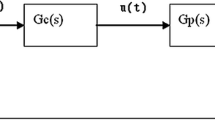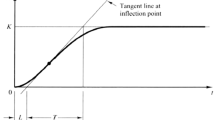Abstract
Digital PID controllers design method in a parameter space is proposed in this article. Sensitivity analysis is processed to meet specifications in gain margin and phase margin. The stability boundary is plotted based on the proposed method in this article. The genetic algorithm is used for integral absolute error, integral time-weighted absolute error, integral square error, and integral time-weighted square error. A design procedure is proposed in this article. The design procedure is applied for a model of a boiler and a model with time delay. Computer simulation results show that the proposed method is effective.
Similar content being viewed by others
References
M. Gopal, Digital Control and State Variable Methods, Mcgraw Hill Education, 2012.
C. Phillips, T. Nagle, and A. Chakrabortty, Digital Control System Analysis & Design, Pearson, 2014.
V. Mummadi, “Design of robust digital PID controller for H-bridge soft-switching booster converter,” IEEE Trans. on Industrial Electronics, vol. 58, no. 7, pp. 2883–2897, July 2011.
J. S. Wang and G. H. Yang, “Data-driven output-feedback fault-tolerant compensation control for digital PID control systems with unknown dynamics,” IEEE Trans. on Industrial Electronics, vol. 63, no. 11, pp. 7029–7039, November 2016.
X. Wei, P. Wang, and F. Zhao, “Design of a decoupled AP 1000 reactor core control system using digital proportional-integral-derivative (PID) control based on a quasi-diagonal recurrent neural network (QDRNN),” Nuclear Engineering and Design, vol. 304, pp. 40–49, August 2016.
L. H. Keel, J. I. Rego, and S. P. Bhattacharyya, “Digital PID design for maximally deadbeat and time-delay tolerance,” IFAC Proceedings Volumes, vol. 35, no. 1, pp. 361–366, 2002.
K. Kim and R. C. Schaefer, “Tuning a PID controller for a digital excitation control system,” IEEE Trans. on Industry Applications, vol. 41, no. 2, pp. 485–492, April 2005.
V. Bobal, J. Machacek, and R. Prokop, “Tuning of digital PID controllers based on Ziegler-Nichols method,” IFAC Proceedings Volumes, vol. 30, no. 21, pp. 145–150, September 1997.
D. E. Rivera and S. V. Gaikwad, “Digital PID controller design using ARX estimation,” Computers and Chemical Engineering, vol. 20, no. 11, pp. 1317–1334, 1996.
K. G. Papadopoulos, N. D. Tselepis, and N. I. Margaris, “Type-III closed loops control systems-digital PID controller design,” Journal of Process Control, vol. 23, no. 10, pp. 1401–1414, November 2013.
O. Yaniv and M. Nagurka, “Robust PI controller design satisfying sensitivity and uncertainty specifications,” IEEE Trans. on Automatic Control, vol. 48, no. 11, pp. 2069–2072, November 2003.
J. W. Perng, S. C. Hsieh, L. S. Ma, and G. Y. Chen, “Design of robust PI control systems based on sensitivity analysis and genetic algorithms,” Neural Computing and Applications, vol. 29, no. 4, pp. 913–923, February 2018.
J. G. Ziegler and N. B. Nichols, “Optimum setting for automatic controllers,” Trans. of the ASME, vol. 64, pp. 759–768, 1942.
H. Hakli and H. Uguz, “A novel approach for automated land partitioning using genetic algorithm,” Expert Systems with Applications, vol. 82, pp. 10–18, October 2017.
A. A. Behar, “Closed loop tuning of discrete PID regulators using genetic algorithms,” IFAC Proceedings Volumes, vol. 40, pp. 250–255, 2007.
M. Mehrgoo and M. Amidpour, “Configurations and pressure levels optimization of heat recovery steam generator using the genetic algorithm method plants based on the constructal design,” Applied Thermal Engineering, vol. 122, pp. 601–617, April 2017.
M. Srinivas and L. Patnaik, “Adaptive probabilities of crossover and mutation in genetic algorithms,” IEEE Trans. on System, Man and Cybernetics, vol. 24, no. 4, pp. 656–667, April 1994.
N. Sharma and K. Singh, “Model predictive control and neural network predictive control of TAME reactive distillation column,” Chemical Engineering and Processing, vol. 59, pp. 9–21, September 2012.
P. Zitek, J. Fis˘er, and T. Vyhlídal, “IAE optimization of PID control loop with delay in pole assignment space,” IFAC-PapersOnLine, vol. 49, no. 10, pp. 177–181, 2016.
M. S. Fadali and A. Visioli, Digital Control Engineering: Analysis and Design, USA Academic Press, 2012.
Author information
Authors and Affiliations
Corresponding author
Additional information
Recommended by Associate Editor Yingmin Jia under the direction of Editor Euntai Kim. This article was supported by the Ministry of Science and Technology, Taiwan, R.O.C. with MOST107-2218-E-032-004.
Jau-Woei Perng was born in Hsinchu, Taiwan, in 1973. He received the B.S. and M.S. degrees in electrical engineering from the Yuan Ze University, Chungli, Taiwan, in 1995 and 1997, respectively, and the Ph.D. degree in electrical and control engineering from the National Chiao Tung University (NCTU), Hsinchu, Taiwan, in 2003. From 2004 to 2008, he was a Research Assistant Professor with the Department of Electrical and Control Engineering, NCTU. Since 2008, he has been with the Department of Mechanical and Electromechanical Engineering, National Sun Yat-Sen University, Kaohsiung, Taiwan, where he is currently an Associate Professor. His research interests include robust control, nonlinear control, fuzzy logic control, neural networks, mobile robots, systems engineering and intelligent vehicle control.
Shan-Chang Hsieh received the B.S. degree from National Kaohsiung Normal University, Taiwan, R.O.C., in 1998. Currently he is working toward a Ph.D. in the area of control systems engineering at National Sun Yat-Sen University, Kaohsiung, Taiwan, R.O.C.. His research interests include control theories, nonlinear systems and applications of control systems.
Rights and permissions
About this article
Cite this article
Perng, JW., Hsieh, SC. Design of Digital PID Control Systems Based on Sensitivity Analysis and Genetic Algorithms. Int. J. Control Autom. Syst. 17, 1838–1846 (2019). https://doi.org/10.1007/s12555-018-0570-3
Received:
Revised:
Accepted:
Published:
Issue Date:
DOI: https://doi.org/10.1007/s12555-018-0570-3




